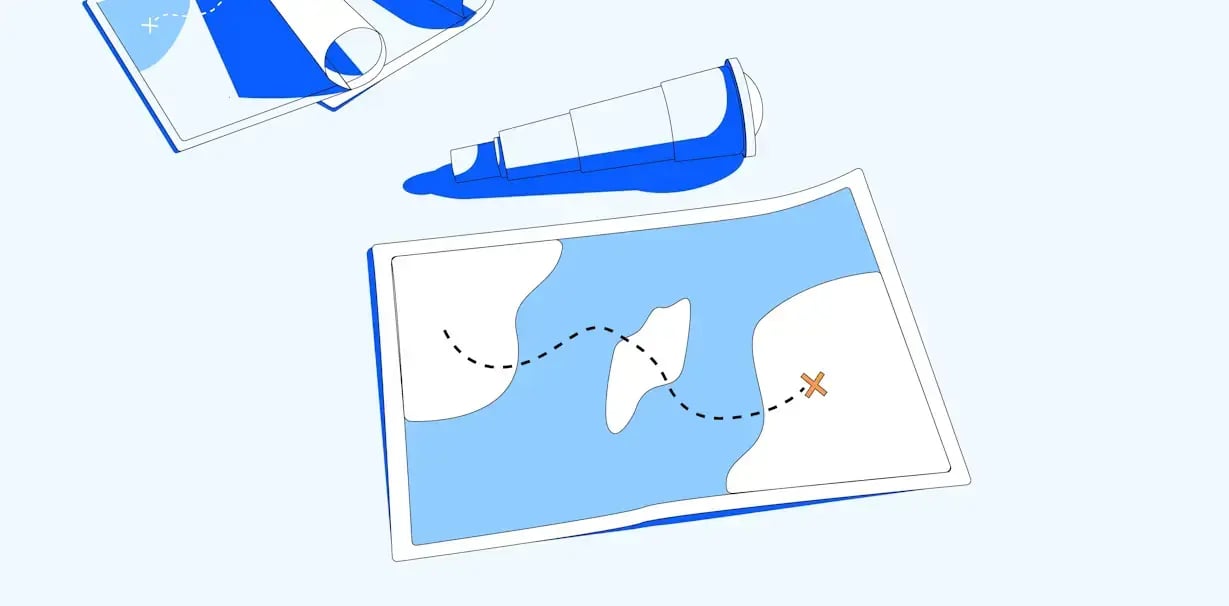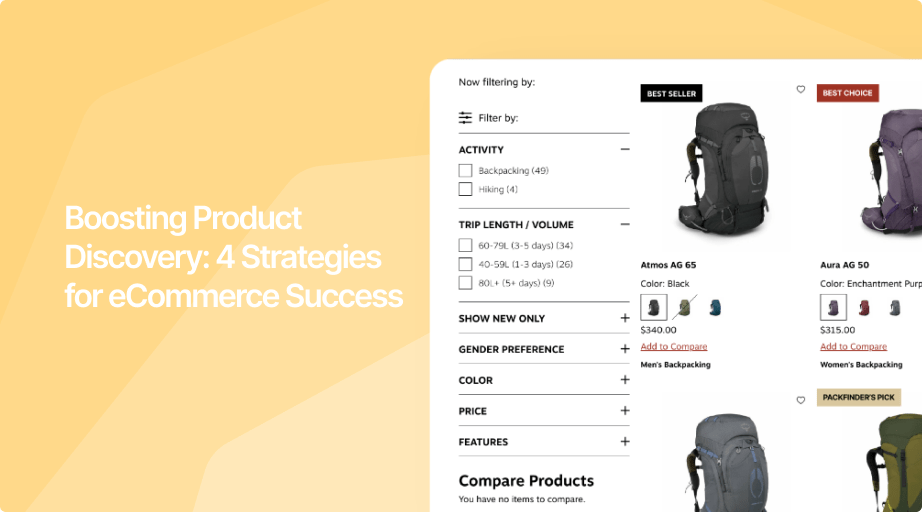Having great products in your online store is not enough. To stand out, eCommerce businesses must make it easy for shoppers to discover the items they want.
At the end of 2024, 2.71 billion shoppers will have browsed online, and most of them will have left a website without making a purchase - simply because they can't find what they are looking for. It’s an eye-opening statistic, especially when you consider the effort and investment that goes into getting a big portion of these customers to your site in the first place.
Product discovery is the process that helps online shoppers find the exact products they are looking for on an eCommerce site. It relates to how customers navigate through categories, search for specific items, and explore recommendations. The more simple this process is, the easier it is for customers to locate what they need - and that leads to higher chances of making a purchase.
Customers expect to find relevant products quickly and easily when they land on a webshop. When they don’t, they abandon carts, move to competitors, or leave the site altogether. Poor product discovery is quietly draining potential revenue from countless eCommerce stores, so focusing on creating a tailored shopping experience that meets customer expectations will bring more conversions, higher business growth, and customer loyalty.
With this in mind, let's explore four powerful strategies to help you win the product discovery game and give the customers exactly what they want in your store.
1. Personalized Recommendations
Having great products in your online store is not enough. To stand out, eCommerce businesses must make it easy for shoppers to discover the items they want, and personalized product recommendations are a great way to achieve that. Product recommendations work by analyzing customer data like browsing history, past purchases, and preferences. By using tools like a product finder, eCommerce platforms can identify customer behavior patterns and suggest items that match their interests. For example, if someone frequently shops for gym wear, the system will prioritize showing them new arrivals or popular items in the gym and fitness category.
It’s like having a digital assistant who knows exactly what your customer is looking for by leveraging zero-party data, which customers willingly share, offering a direct understanding of their preferences. Here’s why personalized recommendations are so powerful in the product discovery process:
Simplifying Product Search
Many shoppers leave websites without buying anything, not because they don’t like the products, but because they can’t easily find what they want. Personalized recommendations simplify this process by presenting products that match customers’ tastes and needs. For example, after browsing through a few jackets, an online store can suggest matching accessories or show similar models that align with the previous jacket searches.
Boosting Engagement with “Recommended for You” Sections
Personalized sections like “Recommended for You” or “You Will Also Like” provide a tailored shopping experience. These dynamic sections encourage customers to explore more, increasing the chance that they will find something they love and make a purchase. This is why you often see personalized recommendations on popular eCommerce sites like Amazon or Nike. Customers will be more likely to check such sections where products are listed based on their previous interests or purchases on the site.
Increasing Retention with Targeted Emails
Personalized emails are another effective way to keep customers engaged. By using data on past purchases and browsing habits, online stores can send personalized emails with product suggestions that align with their interests. For example, a clothing retailer might email a customer with new arrivals in their preferred size and style, give discounts, and make it easy to find what they like. It’s beneficial to keep customers in touch with your brand and build long-lasting relationships.
2. Enhanced Search Functionality: Making Product Discovery Effortless

Boosting product discovery for your customers primarily involves optimizing search functionality | Source
An advanced search function is essential to help customers find exactly what they’re looking for quickly and easily. In a competitive eCommerce landscape like we live in today, a basic search bar with a magnifying glass icon isn’t enough. Shoppers expect a smooth and personalized product search experience that delivers relevant results instantly.
Here is how enhanced search features boost product discovery firsthand:
- Auto-Suggestions: As customers start typing, popular search terms and relevant products should appear instantly, helping them find the items faster. This feature simplifies the product search process, reducing effort and guiding customers directly to items before they type the term.
- Advanced Filtering Options: Allow customers to refine search results by categories like price, size, color, and brand. Filters make it easier for shoppers to navigate large product inventories without getting overwhelmed.
- Natural Language Processing (NLP): By understanding the intent behind a customer’s query (e.g., “best running shoes for women”), NLP can deliver more accurate and contextual results. This approach allows the product discovery to be more conversational, making their shopping experience feel more personalized.
- Spell-Check and Related Searches: These tiny but impactful features boost the customer journey by accurately interpreting customer intent. Even if a customer misspells an item in the search bar, they will be easily directed to relevant results, keeping their product research on track and frustration-free.
3. Interactive Tools: Product Discovery with Engaging Experiences
Interactive tools like quizzes, polls, and even guided questionnaires are becoming powerful ways for eCommerce brands to connect customers with the right products. These tools help shoppers uncover their needs, clarify preferences, and show interest in relevant products or product features. By offering such a personalized and interactive experience, these tools provide a deeper level of engagement and simplify product discovery with relevant recommendations afterward.
For example, consider a beauty store offering a skincare routine questionnaire that identifies individual skin concerns and suggests products tailored to each customer’s needs according to the answers. Here are some popular ways how these interactive tools are used for product discovery today:
- Personalized Quizzes: Quizzes ask tailored questions, like preferred colors, product types, or specific uses, that help identify the best-fit products for each customer. Personalized quizzes reduce choice overload and build confidence by quickly narrowing down a customer’s choices for finding a perfect product.
- Polls and Feedback Forms: Simple polls and surveys collect valuable insights into what customers are looking for, allowing brands to adjust their recommendations accordingly. For example, a poll might ask users about product styles or personal experiences, so this real-time feedback helps shape more accurate recommendations that feel relevant and timely to each customer in the product discovery phase.
- Guided Questionnaires: Step-by-step questionnaires lead users through a precise selection of questions that narrow product options based on specific criteria, like budget, style, or product features. These guided paths offer a structured way to explore products, making it easier for customers to find what best suits their needs. They also build trust, as customers feel their preferences are valued and considered.
4. Guided Selling: A Customer-Centric Route to Product Discovery

Product discovery is the first stage of the customer journey—but it doesn't end there | Source
Guided selling is a modern eCommerce approach for simplifying and enriching the customer journey by giving a clear and personalized path to finding the perfect product. Rather than leaving customers to browse and dig endless choices on their own, guided selling tools like product advisors offer a step-by-step system that tailors product recommendations based on individual preferences and needs. Here’s how it works in different forms for product discovery and why it’s so effective:
Chatbots
Modern chatbots are no longer just for customer service, they have become powerful guided selling tools. By asking targeted questions like a popup or in a specific section of the website, they help customers identify what they are looking for and suggest products that match their preferences. For example, a chatbot on a fitness gear website might ask questions about workout intensity, type of exercises, goals, and budget, then recommend suitable fitness equipment. Chatbots are great for keeping users engaged and focused on direct interaction (communication) with the brand, leading them to relevant options without overwhelming them.
Interactive Guides
Interactive guides serve as virtual shopping assistants, directing users through product categories, styles, or use cases. These guides might show images, videos, or even testimonials as users make their choices, helping them visualize and understand each product option. A skincare website, for example, can use an interactive guide that allows customers to explore products based on skin type, age, or specific concerns like dryness or acne. In this case, the guide helps customers make confident decisions about a specific product available on the website.
Product Advisors
Product advisors are revolutionary tools that lead customers through highly personalized journeys from start to finish. These tools start by analyzing the customer behavior and asking key questions about the needs and goals. Then provide suggestions based on this data, often narrowing down results in real-time. Crobox’s Product Advisor, for example, is an advanced guided selling tool that uses behavioral data to suggest products that align with customer intent, giving a more engaging and relevant product discovery experience.
ASICS is a great example of a sports brand that uses our product advisor where questions are included for the customers to provide answers (information) about their running goals. According to these answers, the tool automatically uses the data to recommend perfectly matching running shoes that fit the customer’s needs and parameters. The customer can instantly see the shoes then, their purpose, the price, and a quick “add to cart” button to finish the product discovery process with a purchase.
This is also a confidence-building approach. Such product selection leads to higher satisfaction and boosts conversion rates, making it an essential strategy for eCommerce success.
Start boosting your Product Discovery today!
To sum up, product discovery should be a frictionless experience for all customers. Using the 4 key strategies we mentioned, your online shopping success should be easily achievable. Here are the key takeaways to keep in mind:
- Boost Personalization: Using data to create tailored recommendations, personalized searches, and customized shopping journeys leads to product relevance and higher engagement.
- Interactive Tools and Guided Selling: Implementing tools like quizzes, polls, and guided selling advisors personalizes the shopping experience, helping customers find products easily that truly meet their needs.
Crobox offers AI-driven guided selling solutions to support the product discovery process. Schedule a demo and find out how we can support your approach.

